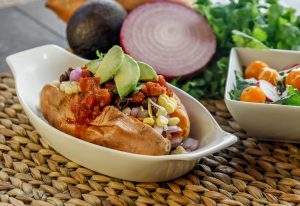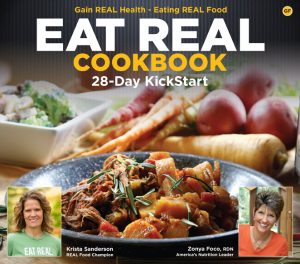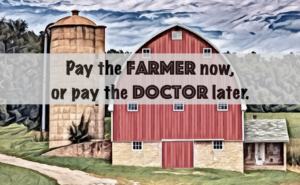 “Eating healthy is too expensive.”
“Eating healthy is too expensive.”
“And it takes too much time.”
We hear this a lot.
Many perceive that it’s too expensive (or too time-consuming) to eat REAL food – or eat healthy.
Recently, after discussing this perception during a lunch-and-learn, someone said, “it is NOT more expensive to eat healthy if you get sick.” This person said she has been struggling with diabetes and the expenses that go along with it.
We all know perception often doesn’t equal reality.
Maybe we can provide some things to think about…and blow the lid off these perceptions!
Consider this…if a family of four chooses to eat dinner out at a middle-of-the-road sit down restaurant, it could easily cost them anywhere from $40 to $50, depending on whether they can still take advantage of the kids’ meal prices. This would likely take at least 45 minutes out of their evening. Or, if they ate at a fast food restaurant, they might be able to get out of there for $25 to $30. If they were to take this same 45 minutes and prepare a meal like the Baked Chicken Parmesan at home, not only would the meal taste 10 times better, but it would cost them a TOTAL of $13 for 4-6 servings. Add the Easy Every Day Salad for four and the cost goes up by only $5!
So, in this scenario, the result of eating REAL, healthy food is significantly higher quality and taste, and a savings of up to $37 with no additional time required!
 A recent study found that, on average, it is 5 times more expensive to order delivery from a restaurant than to cook at home. They also found that meal kit services are almost 3 times more expensive than cooking from scratch. This study was based on evaluating 86 popular dinner recipes.
A recent study found that, on average, it is 5 times more expensive to order delivery from a restaurant than to cook at home. They also found that meal kit services are almost 3 times more expensive than cooking from scratch. This study was based on evaluating 86 popular dinner recipes.
Consider the cost and time required for some other great-tasting Eat REAL America meals:
- Spaghetti Squash Noodle Bowl: $15 total cost; 30 minutes to prepare.
- Slow Cooker Balsamic Pork Tenderloin: $12.50 total cost; 5 minutes to throw together in the morning, and then the slow cooker does all the work!
- Southwest Stuffed Sweet Potato: $8 total cost and 20 minutes to prepare.
Some may say: “Yes, eating out is more expensive, but I can eat at home for significantly less than $20 and much quicker than 45 minutes.”
It’s true — you can throw a frozen pizza in the oven and feed four people for $4. However, with just a little planning, this same family can enjoy a healthy, great-tasting meal for not much more money. For example, using the leftovers from the Slow Cooker Balsamic Pork Tenderloin, a family of four could make Pork and Balsamic Onion Quesadillas, and this meal would only cost $3.50 and only require 20 minutes!
Plus, that $4 frozen pizza doesn’t reflect the “true cost.”
 A diet of frozen pizzas and other processed foods increases the risk of illness, doctors’ visits and medication…so this cost has to be factored in to what may otherwise appear to be “cheap” food.
A diet of frozen pizzas and other processed foods increases the risk of illness, doctors’ visits and medication…so this cost has to be factored in to what may otherwise appear to be “cheap” food.
The American Journal of Preventative Medicine estimated that it costs $85,000 on average to treat type 2 diabetes over a person’s lifetime. And, earlier this year, the American Diabetes Association estimated the total cost of treating diagnosed diabetes at $327 billion (vs. $245 billion when this was last studied in 2012).
A study led by the Harvard School of Public Health estimated the cost difference between eating healthy and unhealthy is $1.50/day. That is more than many spend on a cup of coffee every day!
We believe it IS possible to eat healthy without spending more, but even at $1.50 a day, what a great investment for improved health and the enjoyment that comes from absolutely delicious, REAL food meals.
We often spend money to get a better phone, better TV or better car, so why wouldn’t we invest in “better food?”
Try these ideas to incorporate better-tasting, REAL food into your routine…and save some money in the process:
1. Stock your pantry and freezer! Stocking your kitchen pantry and freezer with useful staple ingredients and seasonings can help reduce the cost (or perceived cost) of REAL meals. Sure, a bottle of dried oregano might cost $2, but the amount called for in a specific recipe is much less. For example, the Baked Chicken Parmesan calls for 1 tsp of oregano, meaning the oregano for this meal costs $0.40. So, it’s important to use these staples on a regular basis and not attribute the entire cost to one meal. Our pantry staple list is a great guide. And, consider stocking up on beans and lentils – easy to cook ahead of time and super inexpensive!
 2. Buy in-season and local! The cost of produce can vary significantly depending on whether it is in-season or out-of-season. The cost of some fruits and vegetables can be 50% less when they are purchased in-season. When in-season isn’t available, frozen fruits and vegetables and canned tomatoes are excellent, affordable alternatives. Also, buying directly from the producers – or even growing your own – can save money by eliminating the middle-man and transportation costs.
2. Buy in-season and local! The cost of produce can vary significantly depending on whether it is in-season or out-of-season. The cost of some fruits and vegetables can be 50% less when they are purchased in-season. When in-season isn’t available, frozen fruits and vegetables and canned tomatoes are excellent, affordable alternatives. Also, buying directly from the producers – or even growing your own – can save money by eliminating the middle-man and transportation costs.
3. Don’t turn your nose up at leftovers! Many recipes taste even better the next day. Enjoying leftovers for lunch or dinner (or even breakfast) is a great way to get the most out of your meals. For certain meals (like soups and stews), leftovers can be packaged in individual containers and frozen, and then simply reheated on those busy weeknights for a convenient, inexpensive REAL food meal! Also, many slow cooker meals can be quickly transformed into delicious and inexpensive “planned-over” meals. This is a trick we teach in our Eat REAL Cookbook.
 4. Make planning a priority! Planning is important so you don’t get “stuck” with only poor food choices. Think about when you are at a kid’s ballgame. You can either bring a sandwich or a snack (which probably costs $1 or less) or visit the concession stand, where the options typically consist of hot dogs and nachos (which are often $2 or more). A little planning can go a long way in reducing your food costs and enjoying better-tasting, more satisfying meals and snacks. See our coaching tip for more info on planning and snack ideas.
4. Make planning a priority! Planning is important so you don’t get “stuck” with only poor food choices. Think about when you are at a kid’s ballgame. You can either bring a sandwich or a snack (which probably costs $1 or less) or visit the concession stand, where the options typically consist of hot dogs and nachos (which are often $2 or more). A little planning can go a long way in reducing your food costs and enjoying better-tasting, more satisfying meals and snacks. See our coaching tip for more info on planning and snack ideas.
5. Be conscious of the true cost of what you eat! As we mentioned, a diet high in processed food increases cost associated with illness, doctors’ visits and medications. Processed food also doesn’t leave you as satisfied as REAL food, which means you will probably “need” additional snacks and foods, further increasing the cost.
We know it’s not the normal way of thinking in today’s culture, but we firmly believe it doesn’t have to be more expensive to eat healthy – and eat REAL food!
We know our Eat REAL America members understand the value of REAL food and healthy eating, but we bet you may know someone who might benefit from this information, so please share this with them!


Paul Freimuth
paul.freimuth@hyatt.com
Once again, more great info to live by. When I have leftovers I call it repurposing them! lol
Thank you! Definitely jazzing up and changing the word “leftovers” can make a big difference! Ha!